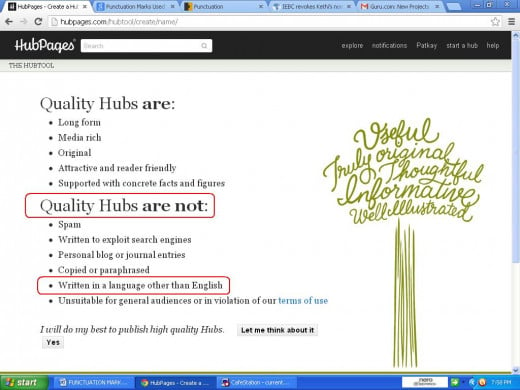Punctuation Marks Used In English Language
The English Language is the Most Commonly Used
The English language is the most commonly used in many countries for communication. When you come to the World Wide Web, the same case applies.
Most of the millions of articles that have found their way to the Internet are in the English language. I am not denying the fact that there are other languages some less common and others commonly used too.
You can mention the likes of German, Portuguese, Hindi, Afrikaans, French, among others.
Article Writing

Importance of Punctuation Marks
- Punctuation marks help us to make sense (head or tail) of what we are reading. As you read a sentence, you need occasional pauses if it is a long sentence and a stop when the sentence ends.
- Punctuation symbols define how words relate to each other.
- Properly used punctuation symbols will help you know when a sentence comes to an end. They let you know when to take a breath when to pause when to become excited when to lift your voice. When to ask a question and they will let you know when you are about to start a new sentence.
English Language is Used Widely by Online Writers
Looking at the articles found on the internet, you will find that many of the writers have favoured the use of the English language as their tool of communication.
It could be because more people are making money from creative writing and posting their articles on the web. However, looking at some of the articles, they are in a very poor language standard.
It is such a poor language standard that can make an Englishman using the Queen’s English puke upon reading such articles. I am not claiming my English is perfect, but you need to know how to make use of punctuation marks effectively.
Full Stop (.)
A full stop is also known as a period. It is used to denote the end of a complete sentence. A sentence is a complete statement usually containing a verb.
This means when your sentence comes to an end, use a full stop at the end of it. The full stop is just a single dot.
Comma (,)
- A comma is used to indicate a short pause.
- The comma can also be used to denote a series of items for instance sheep, cows, goats, and horses.
- A comma can also be used when the subject has two or more adjectives being used to describe it.
- A comma can also be used with a sentence that adds information and supplements the subject. Brigid Kosgei, the lady who broke the marathon record, is coming to town.
- The comma can also be used to separate an introductory phrase from the rest of the sentence.
Semicolon (;)
- A semicolon is used to give a stronger pause as opposed to a comma.
- The semicolon is also appropriate for separating two related but independent clauses.
- Another common use of a semicolon is to separate a series of complex items especially when they have commas in them.
The colon (:)
- The colon is used to introduce a list but not a regular series. Usually, the word following denotes the use of a colon. A colon should be used only after a full sentence that is ending with a noun.
Apostrophe (‘)
An apostrophe is used for the following purpose:
- To tell the reader when a thing is owned by another, for instance, the boy’s toy.
- To tell the reader when a word has been made short or has been contracted for instance won’t, can’t, haven’t, among others.
When dealing with singular nouns, add an apostrophe at the end of the word and then an “s” for instance cat, milk. If the word is a singular noun, add an “s”.
- James’s book
- James’ book
For plural nouns
Only the apostrophe is required for instance boys’ bikes, dog’s meat.
Speech Marks (“ “)
They are also known as quotation marks. They are useful in day to day writing. There are commonly used to record exactly what someone said. The recording of what someone has said can be done in the following ways:
a) Direct speech – this is a recording of exactly what was said. What was spoken is put inside the speech marks.
b) Indirect speech – this is the recording of what was said but not in the very exact word.
Always remember that all punctuations of a speech go inside speech marks.
Exclamation mark (!)
The exclamation mark indicates emphasis or excitement in a sentence. For instance, in a sentence, come here now!
Question mark (?)
A question mark is used at the end of a sentence that suggests inquiry or interrogatory remark. What is your name, please?
Did you gain something out of this article?
This content is accurate and true to the best of the author’s knowledge and is not meant to substitute for formal and individualized advice from a qualified professional.
© 2013 Patrick Kamau








